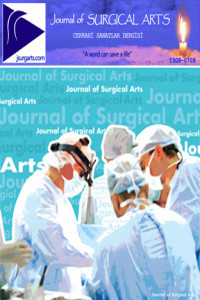Pleurodesis methods in the surgical treatment of primary spontaneous pneumothorax
Pneumothorax is the collection of air in the pleural space. Pneumothorax can be spontaneous, traumatic or iatrogenic. Primary spontaneous pneumothorax mostly occurs in healthy individuals without an apparent cause, probably due to the rupture of subpleural emphysematous bullae located on the apex of the lung. It usually occurs in tall and healthy males younger than 40 years old. Primary spontaneous pneumothorax has a recurrence rate of 20-30% after the first attack, 50% after the second attack, and 80% after the third attack. Surgery is presented as a treatment option to reduce the high recurrence rate after the second attack. It has been reported that recurrence is between 10 and 20% in patients who undergo bullectomy or wedge resection with endoscopic steps alone. Therefore, various pleural pleurodesis methods are applied in addition to bulla resection in order to reduce the recurrence rate after surgery. In mechanical pleurodesis, adhesion between visceral and parietal pleura is achieved by mechanical abrasion of the parietal pleura or by total or partial removal of the parietal pleura. In chemical pleurodesis, the visceral pleura is adhered to the parietal pleura by creating irritation in the pleura with chemical agents. In cases where pleurodesis was added, the recurrence rate was reported to be between 1.7 and 2.8%. Whether the pleurectomy, pleural mechanical or chemical abrasion methods performed with video-assisted thoracoscopic surgery is superior for preventing recurrence is still a matter of debate. In this article, we aimed to discuss the advantages and disadvantages of pleurodesis methods in the surgical treatment of primary spontaneous pneumothorax in the light of the literature.
Anahtar Kelimeler:
Pnömotoraks, plörodezis, cerrahi
Pleurodesis methods in the surgical treatment of primary spontaneous pneumothorax
Pneumothorax is the collection of air in the pleural space. Pneumothorax can be spontaneous, traumatic or iatrogenic. Primary spontaneous pneumothorax mostly occurs in healthy individuals without an apparent cause, probably due to the rupture of subpleural emphysematous bullae located on the apex of the lung. It usually occurs in tall and healthy males younger than 40 years old. Primary spontaneous pneumothorax has a recurrence rate of 20-30% after the first attack, 50% after the second attack, and 80% after the third attack. Surgery is presented as a treatment option to reduce the high recurrence rate after the second attack. It has been reported that recurrence is between 10 and 20% in patients who undergo bullectomy or wedge resection with endoscopic steps alone. Therefore, various pleural pleurodesis methods are applied in addition to bulla resection in order to reduce the recurrence rate after surgery. In mechanical pleurodesis, adhesion between visceral and parietal pleura is achieved by mechanical abrasion of the parietal pleura or by total or partial removal of the parietal pleura. In chemical pleurodesis, the visceral pleura is adhered to the parietal pleura by creating irritation in the pleura with chemical agents. In cases where pleurodesis was added, the recurrence rate was reported to be between 1.7 and 2.8%. Whether the pleurectomy, pleural mechanical or chemical abrasion methods performed with video-assisted thoracoscopic surgery is superior for preventing recurrence is still a matter of debate. In this article, we aimed to discuss the advantages and disadvantages of pleurodesis methods in the surgical treatment of primary spontaneous pneumothorax in the light of the literature.
Keywords:
Pnömotoraks, cerrahi, plörodezis,
- ISSN: 1308-0709
- Başlangıç: 2008
- Yayıncı: Osman Nuri DİLEK
Sayıdaki Diğer Makaleler
Pleurodesis methods in the surgical treatment of primary spontaneous pneumothorax
Bilateral giant inguinoscrotal hernia with hydrocele. A case report
Ozan KAYA, Elçin ERSÖZ KÖSE, Murat KAVAS, Cansel ATİNKAYA BAYTEMİR, İrfan YALÇINKAYA
Giant left atrial myxoma presenting as cerebral embolism
Funda TOR OCAK, Muhittin Zafer SAMSA
Pseudomyxoma peritonei presenting with port site hernia
Serkan KARAISLI, Atahan ACAR, Feyyaz GÜNGÖR, Murat Kemal ATAHAN
Vikram YOGİSH, Sugandh AROCKİYASEKAR, Akhil AVİRNENİ
Ultrasound assisted catheterization of internal jugular vein
